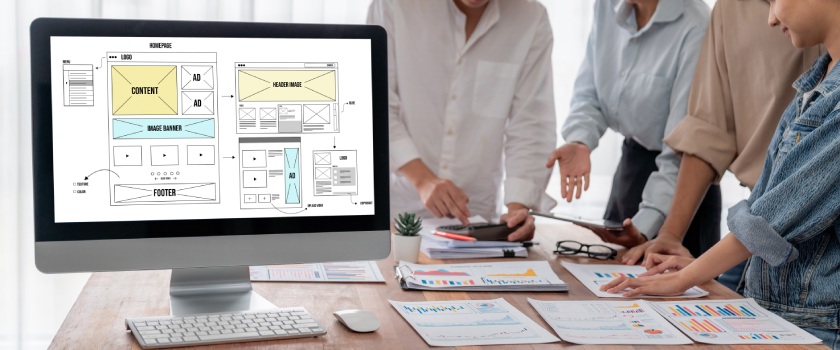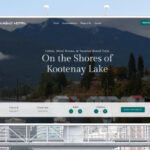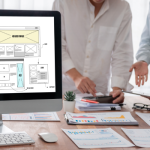The most important page of any business’s website, the homepage is where most new customers land, whether they arrive from a traditional search engine, AI platform, or external link. The impression a potential guest receives there determines whether they explore your site further or leave immediately.
A hotel homepage should be visually appealing and tell a story that entices visitors to dive deeper, intuitively guiding them along their own path to booking. Here are our top tips to make sure it does just that.
Reflect Your Brand and Target Market
If your homepage reflects your property’s personality or brand, it should also naturally reflect your target market(s). You want potential guests to land there and think, “This is my kind of place.”
Central to visual design, color creates brand recognition and customer appeal. Choose your palette carefully, in alignment with your brand colors or logo and the emotional response you want to elicit. For example, black, gray, purple, and gold are typically associated with luxury; greens, blues, and browns with calmness and nature; and bright blues, red, orange, and yellow with energy and fun. But don’t get carried away—too many colors can be distracting or overwhelming. As a rule of thumb, stick to a simple scheme of three main colors that work well together: the background color (a neutral color) and a couple of accent colors (brand colors).
Tone of voice through written content is also important for conveying your brand. Choose wording that reflects your property’s personality (edgy, sophisticated, relaxed, fun) and who your guests are. For instance, a conference hotel would likely choose a professional tone, while a backpackers’ hostel may feature a casual, playful voice. Inject personality into written content to strike a chord with customers—and whether your brand voice is formal or informal, ensure that all written content is well edited (no grammar errors or spelling mistakes!).
Answer the Most Important Questions
Visitors to your homepage are looking for information about your property. While you can’t answer everything there, certain details should be easily available. Consumers take just a few seconds to decide if they like a website/business enough to explore further, so give them the answers to their burning questions upfront.
Think of your homepage as an overview of your property and the stay experience.
>> Who are you?
A short written introduction along with well-chosen images and your website’s visual design should convey the essence of your property.
>> Where are you?
While your website should feature a separate “Location” or “Contact” page with a map and other helpful information, your property’s location should also be immediately apparent on your homepage. It can be mentioned within the written introduction as appropriate, and contact information (physical address, email, and phone number) should be included in the header or footer to make it as easy as possible for customers to reach you.
>> What do you offer?
While other pages dedicated to room types, packages, services, and amenities show complete information about what your property offers, your homepage should introduce the fundamentals, inviting visitors to learn more with CTAs (calls to action) leading to applicable pages. For example, your homepage could highlight your most popular room types, with a “View Our Rooms” button that takes visitors to your “Rooms” page for further details and images.
>> How are you different?
Your USP (unique selling proposition) sets you apart from your competition and should be promoted front and center. Whether it’s your super convenient location or mouth-watering restaurant, highlight your USP through written copy and images. Featuring positive reviews that praise your property’s distinctive features is also a great way to convey that USP while boosting credibility.
>> How can guests book or contact you?
The main purpose of your hotel’s website is to drive bookings, so make it easy for customers to reserve online or contact your property directly. Your “Book Now” CTA should always be readily accessible, ideally displayed in the main menu on every page (even better in a sticky menu that stays visible at the top of the screen as the user scrolls). It can also be included elsewhere on the homepage as appropriate, for example, via an availability search widget and/or along with room descriptions. As mentioned above, contact details should also be present within the header and/or footer along with your social media icons.
Clear Navigation
If your homepage appeals, most visitors want to explore your website further before making the decision to book. Whether they’d like to view images of your rooms, confirm that you offer specific amenities, find prices, or learn more about your neighborhood, the things that matter to your visitors will vary. Each visitor follows their own path to purchase, so intuitive navigation is key to conversion.
Keep navigation simple with a main menu at the top of the page and strategically placed CTAs throughout. Using a conventional menu style such as a horizontal menu for desktop and hamburger menu for mobile makes navigation instinctive through familiarity. To include additional content without overwhelming the layout, consider incorporating drop-down submenus.
It should be clear to users how to get to the information they want next—either through your menu or CTAs—and it should only ever be a single click away. If visitors can’t find it fast, you risk losing them to a competitor.
High-quality Images
High-quality photography is essential for a hotel website—especially a homepage—that aims to convert lookers to bookers. Images resonate with viewers and play a vital role in their first impression; the human brain absorbs visuals 60,000 times more quickly than text.
When it comes to your homepage, screen-spanning hero images or sliders are an effective way to immediately capture your audience’s attention and convey your stay experience. Choose four to six of your best high-resolution photos that together give a good overview of your property’s story for your homepage slider.
Because consumers buy with their eyes, it pays to invest in professional photography. Images that sell are composed well and show your property in its best light, from the right angle.
Simple Design
Users prefer websites that are visually uncluttered and easy to navigate and understand. A simple design removes unnecessary distractions, focusing visitors on what’s important with easy-to-read font, concise written content, quality images, and plenty of white space.
Simple design is especially important for mobile devices as they have much smaller screens. And as of 2024, 62.54 percent of website traffic worldwide originated from mobile, making mobile optimization every bit as critical as desktop in your design strategy.
A mobile-first approach is a great way to ensure an uncluttered, intuitive design that generates bookings across all devices.
Establish Trust
You need to gain trust to convince travelers to spend their hard-earned money with your business. There are several ways for your homepage to earn the trust of website visitors, starting with a professional design. While an outdated or amateur-looking design does little to inspire confidence, a polished, user-friendly, secure website gives credibility.
As well, badly written content comes across as unprofessional, so polished, error-free copy is also crucial. If a business doesn’t have the time or resources to invest in effective communication, where else are they cutting corners?
You can reassure customers that your business can be trusted by including a hand-picked selection of positive guest reviews on your homepage (or embed a review feed from a site like Tripadvisor) and/or badges for your property’s professional affiliations and awards.
The most important page of a hotel website, the homepage needs to make a good impression fast. Follow the above tips to grab your customers’ attention, convey your property’s unique stay experience, and guide those customers confidently along their path to booking.
If you’re considering a redesign for your property’s website, contact us for a free, no-obligation chat with one of our helpful designers.



